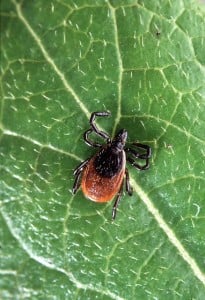 It’s summertime, which means outdoor play, hiking, gardening — and tick bites. The creepy crawlies tend to latch on during the summer months and these arachnids are ubiquitous throughout the U.S.
It’s summertime, which means outdoor play, hiking, gardening — and tick bites. The creepy crawlies tend to latch on during the summer months and these arachnids are ubiquitous throughout the U.S.
But tick bites are more than just an annoying spring and summer nuisance. Each year, about 300,000 people in the U.S. catch Lyme disease, which is caused by bacteria, from a tick bite, the Centers for Disease Control and Prevention estimates. Thousands more develop tick-borne diseases such as the malarialike disease babesiosis, the flulike anaplasmosis and the Heartland virus infection.
But people can take steps to avoid the nasty critters, beyond the old-standby advice to cover up and avoid tall grass, experts say. From wood chips to a quick ride in the dryer, here are 10 ways to avoid tick bites.
1. Repel the bugs
Insecticides can be used to repel ticks, said Thomas Mather, a public health entomologist at the University of Rhode Island, and the director of tickencounter.org.
Permethrin, the insecticide found in antimalarial bed nets, kills adult ticks as well as those in their larval stage, called nymphs, which are the likeliest to harbor Lyme disease.
Ideally, people should buy permethrin-treated clothing, socks and shoes, Mather said.
By contrast, evidence suggests that the more common bug spray chemical, N,N-Diethyl-meta-toluamide (DEET), isn’t useful against ticks.
“It’s not toxic to the ticks,” Mather told Live Science. “They still can scurry across a DEET-treated surface, and get to places where the DEET is not,” such as a warm human leg, he said.
2. Be vigilant at home
Hiking and camping aren’t the most common ways to catch a tick-borne disease, said Kirby Stafford III, the state entomologist at The Connecticut Agricultural Experiment Station and the author of the “Tick Management Handbook.”
“We estimate three-fourths of people pick up the ticks in activities in and around the home,” with children’s play and gardening being some of the riskiest activities, Stafford told Live Science.
Parents should also make sure to do tick checks on children when they come in, he said.
3. Stay in the sun
Tick nymphs have leaky cuticles, or outer covers, that rapidly lose moisture. As a result, they can’t survive in environments with lower than 80 percent humidity for more than eight hours, Mather said.
As a result, nymphs congregate in leaf piles in shady, humid environments, so sticking to sunny areas can reduce tick exposure, he said.
4. Change the landscape
Most ticks around homes stay within a few yards of the interface between the yard and a wooded area, Stafford said.
To keep the yard tick-free, use landscaping that deters mice, deer, woodchucks and other rodents that carry ticks, he said. People should also remove tick habitat such as leaf piles, shrubs and groundcover near the house. Play sets should be kept in the sun, away from the shade, he added.
Ticks won’t cross a barrier of wood chips placed around the yard’s perimeter, perhaps because the dry material makes them dry out too much, he said.
Read the entire list here.
Content provided by http://www.huffingtonpost.com/2014/06/14/avoid-tick-bites-summer_n_5474567.html?ir=Healthy+Living
Read more
Three days into his quest to break the Pacific Crest Trail’s speed record, Josh Garrett collapsed of heat stroke in the dry, desolate landscape of Southern California’s San Felipe Hills.
Dehydrated and exhausted, the 30-year-old Santa Monica, Calif. resident had real doubts about his ability to complete the 2,655-mile trail from Mexico to Canada in less than 60 days.
“I started shivering in the 100 degree heat,” said Garrett, a physiology professor and cross-country coach at Santa Monica College. “I took 24 hours off and really didn’t think I could continue. Needless to say, I’m glad that I didn’t stop.”
Garrett powered through that moment and continued across one of the world’s most spectacular trails at warp speed, eating up 45 miles per day as he crossed from California to Oregon to Washington.
At 8:15 p.m. on Thursday, he reached British Columbia and the trail’s end after a total of 59 days, 8 hours and 59 minutes. It was the fastest time in the trail’s history, breaking the record set just two days earlier by Heather “Anish” Anderson of Bellingham, Wash., who completed the hike in 61 days and about 17 hours.
The previous record was set in 2011 by Scott Williamson of 64 days, 11 hours and 19 minutes.
While the record is informal — no official group tracks the marks — Jack Haskel of the Sacramento-based Pacific Crest Trail Association said he had no reason to doubt Garrett, Anderson or Williamson’s times.
Garrett did the entire trek on a vegan diet as a way to raise awareness about cruelty to animals.
“No matter how painful it was, I always kept in mind that it’s nothing compared to what animals go through at factory farms. This trip was all about them,” Garrett said. “I wanted to stress that a vegan diet gives you everything you need for this kind of endeavor.”
Garrett said his pack averaged about 15 pounds and that a support vehicle resupplied him with food at places where the trail reached the road. His pack bulked to about 30 pounds during the longest and most difficult stretch in the High Sierra Mountains of Northern California, where he went about 200 miles and five days without being able to replenish his supplies.
He started on the trail around 6 a.m. each day and, without stopping for lunch or snacks — eating food as he walked — continued until around 1 a.m.
“I’d usually turn the headlamp on at 9:30 p.m. go into dark for about four hours,” Garrett said. “That was the graveyard shift. I’d usually get three to four hours of sleep. The thing that really surprised me was how well the body adapts to the load you place on it.”
On the best days, Garrett hiked over 50 miles and said he got stronger as time progressed. There wasn’t much time to stop and smell the roses, but he said he did enjoy the scenery as he hiked.
The final six weeks took a toll on his feet – “I haven’t had a pain-free step in over six weeks,” he said – but kept moving with the knowledge that Anderson was just a few days ahead of him and was likely to break the old record.
When the finish line came into view, on the Canadian border on the edge of Manning Park in British Columbia, he sprinted to the finish line and into the arms of his girlfriend.
“It was a great moment,” he said, “and I just cried. I’d been thinking about that moment for such a long time.”
“More than anything, I just feel relieved to know that I don’t have to race off tomorrow morning to hike 50 miles until 2 a.m. in the morning. It really feels good.”

Scurich Insurance Services has proudly served the Monterey Bay area since 1924. Scurich will take care of all of your insurance needs. Are you a business owner, did you get a new car or maybe you are looking to protect your family in the event of a tragedy? Give us a call, we can help!
We are located at:
Scurich Insurance Services
320 East Lake Avenue, PO Box 1170
Watsonville, CA 95077-1170
Office: 1-831-722-3541
Toll Free: 1-800-320-3666
Information provided by: http://www.usatoday.com/story/travel/destinations/2013/08/12/pacific-crest-trail-hiking-record/2642917/
Zach Urness, Salem Statesman Journal 3:03 p.m. EDT August 12, 2013
Read more
 It’s summertime, which means outdoor play, hiking, gardening — and tick bites. The creepy crawlies tend to latch on during the summer months and these arachnids are ubiquitous throughout the U.S.
It’s summertime, which means outdoor play, hiking, gardening — and tick bites. The creepy crawlies tend to latch on during the summer months and these arachnids are ubiquitous throughout the U.S.
